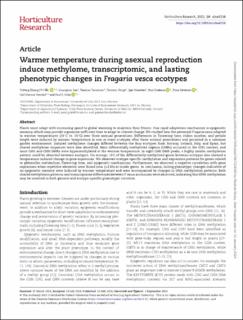| dc.contributor.author | Zhang, Yupeng | |
| dc.contributor.author | Fan, Guangxun | |
| dc.contributor.author | Toivainen, Tuomas | |
| dc.contributor.author | Tengs, Torstein | |
| dc.contributor.author | Yakovlev, Igor | |
| dc.contributor.author | Krokene, Paal | |
| dc.contributor.author | Hytönen, Timo | |
| dc.contributor.author | Fossdal, Carl Gunnar | |
| dc.contributor.author | Grini, Paul | |
| dc.date.accessioned | 2024-01-17T15:53:57Z | |
| dc.date.available | 2024-01-17T15:53:57Z | |
| dc.date.created | 2023-10-21T13:56:44Z | |
| dc.date.issued | 2023-07-31 | |
| dc.identifier.citation | Zhang(张宇鹏), Y., Fan, G., Toivainen, T., Tengs, T., Yakovlev, I., Krokene, P., Hytönen, T., Fossdal, C. G., & Grini, P. E. (2023). Warmer temperature during asexual reproduction induce methylome, transcriptomic, and lasting phenotypic changes in Fragaria vesca ecotypes. Horticulture Research, 10(9). | en_US |
| dc.identifier.issn | 2662-6810 | |
| dc.identifier.uri | https://hdl.handle.net/11250/3112301 | |
| dc.description.abstract | Plants must adapt with increasing speed to global warming to maintain their fitness. One rapid adaptation mechanism is epigenetic memory, which may provide organisms sufficient time to adapt to climate change. We studied how the perennial Fragaria vesca adapted to warmer temperatures (28°C vs. 18°C) over three asexual generations. Differences in flowering time, stolon number, and petiole length were induced by warmer temperature in one or more ecotypes after three asexual generations and persisted in a common garden environment. Induced methylome changes differed between the four ecotypes from Norway, Iceland, Italy, and Spain, but shared methylome responses were also identified. Most differentially methylated regions (DMRs) occurred in the CHG context, and most CHG and CHH DMRs were hypermethylated at the warmer temperature. In eight CHG DMR peaks, a highly similar methylation pattern could be observed between ecotypes. On average, 13% of the differentially methylated genes between ecotypes also showed a temperature-induced change in gene expression. We observed ecotype-specific methylation and expression patterns for genes related to gibberellin metabolism, flowering time, and epigenetic mechanisms. Furthermore, we observed a negative correlation with gene expression when repetitive elements were found near (±2 kb) or inside genes. In conclusion, lasting phenotypic changes indicative of an epigenetic memory were induced by warmer temperature and were accompanied by changes in DNA methylation patterns. Both shared methylation patterns and transcriptome differences between F. vesca accessions were observed, indicating that DNA methylation may be involved in both general and ecotype-specific phenotypic variation. | en_US |
| dc.language.iso | eng | en_US |
| dc.publisher | Oxford University Press | en_US |
| dc.rights | Navngivelse 4.0 Internasjonal | * |
| dc.rights.uri | http://creativecommons.org/licenses/by/4.0/deed.no | * |
| dc.title | Warmer temperature during asexual reproduction induce methylome, transcriptomic, and lasting phenotypic changes in Fragaria vesca ecotypes | en_US |
| dc.type | Peer reviewed | en_US |
| dc.type | Journal article | en_US |
| dc.description.version | publishedVersion | en_US |
| dc.rights.holder | © TheAuthor(s) 2023 | en_US |
| dc.source.volume | 10 | en_US |
| dc.source.journal | Horticulture Research | en_US |
| dc.source.issue | 9 | en_US |
| dc.identifier.doi | 10.1093/hr/uhad156 | |
| dc.identifier.cristin | 2187118 | |
| dc.relation.project | Norges forskningsråd: 249958 | en_US |
| dc.source.articlenumber | uhad156 | en_US |
| cristin.ispublished | true | |
| cristin.fulltext | original | |
| cristin.qualitycode | 1 | |

